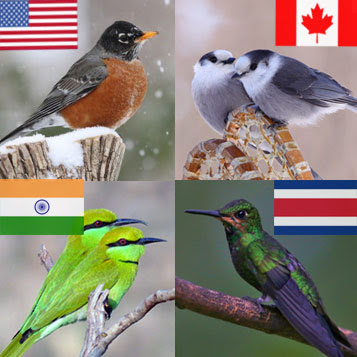
A United Nations of bird expectations for this year’s Great Backyard Bird Count (photos via GBBC photo gallery, clockwise): American Robin by John Skene from Indiana, U.S.A.; Gray Jays by Rejean Turgeon from Quebec, Canada; Green-crowned Brilliant by Bob Shettler from Monteverde, Costa Rica; Green Bee-eater by Dr. Sukhendu Mukhopadhyay from West Bengal, India. |
It’s Almost Bird Count Time!
The Great Backyard Bird Count (GBBC) begins this Friday, February 13! Count birds for just 15 minutes, or count all 96 hours until the end of Monday—just be sure to count!
The GBBC broke records in 2014—with more than 140,000 people from 135 countries counting more than 33 million birds. Help us achieve even bigger numbers this year!
Read the GBBC 2015 preview—including the latest on winter finch movements and international birding expectations—on our All About Birds blog. Then get ready to count later this week. Registration is free and easy. If you’ve counted in the GBBC since 2013 or if you participate in another Cornell Lab citizen-science project, you’re already registered…just count and have fun!
Study up on your tricky birds: Is that a flicker or a sapsucker? A Black-capped Chickadee or a Carolina Chickadee? A Cooper’s Hawk or a sharp-shinned? This Tricky Bird IDs primer will help you distinguish these species.
Pledge to Fledge: New this year, the GBBC is joining a grassroots campaign to encourage birders to mentor someone else and share their love of birds. Take the pledge online and you’ll receive a tip sheet on “How to Fledge a New Birder.” |
Birds + Kids = Inspiration
The Cornell Lab’s Celebrate Urban Birds program introduces students to science and birds. The program reaches many kids from inner cities who don’t have much experience with birds or exposure to careers in science.
The result is more than a crash course in ornithology—it’s a young person’s realization of their scientific potential.
Watch this video to see the inspiration happen.
Get a Celebrate Urban Birds starter kit: Classroom teachers, homeschool educators, interested parents—this kit is your children’s portal into citizen science. Each kit includes materials like colorful posters and data sheets for performing scientific tallies. Order or download your kit today!
Be inspired: The Celebrate Urban Birds blog features ideas for incorporating birds into fun learning, such as creating art from bird haiku.
|
Which Species Is This?
This state bird of South Carolina has recently been spending the winter in places as far north as Minneapolis, Milwaukee, and Montreal. It’s just one of a few species with winter ranges that are shifting farther north. Find out who this new snowbird is and learn about some other birds that are overwintering in new places.
|
Baby Boom on the Bird Cams
Laysan Albatrosses, Season 2: On January 31, Niaulani—an albatross chick on the island of Kauai—hatched under the watchful eye of Malumalu, the mother. Watch Niaulani grow up from a hatchling just six inches long to a massive bird with a seven-foot wingspan by the time it fledges in July.
Great Horned Owls: Two downy young owlets are eagerly taking bits of food from their mother when their father delivers prey. Watch them while you can-—the owlets will grow quickly and are estimated to fledge from their nest in mid-March.
Can’t get enough winter? Watch a bevy of winter birds—Common Redpolls, Pine Grosbeaks, Evening Grosbeaks—on our Ontario FeederWatch Cam.
|

Flocks of Common Redpolls are swooping down into the Lower 48 right now. Photo by Gary Fairhead via Birdshare.
The Redpolls are Coming! The Redpolls are Coming! (And Siskins, Too)
About every other year, cold winter winds blow flurries of two boreal birds—Pine Siskins and Common Redpolls— down from Canada to scatter about the Lower 48 states.
This winter, it’s time for another irruption.
eBird data show that Common Redpolls are reaching the Chicago area in the Midwest and moving down past New Jersey along the Atlantic Coast. Birders are reporting Pine Siskins all the way down in Florida and Texas.
Read our story on the All About Birds blog about what drives this irruption, how to identify redpolls and siskins, and how you might attract them to your backyard bird feeder.
|
| Go Birding in Portugal: Living Bird editor Tim Gallagher gives a recap of his recent birding trip to southwest Europe.
Winter Irruptives Slideshow: Flip through photos of uncommon birds from Project FeederWatchers this winter.
Take a Road Trip: Our Upcoming Bird Festivals and Events webpage makes it easy to plan your next birding destination. You can look through listings by calendar or on a map, so you can start planning your road trip right from the page. |
|
|
|
|